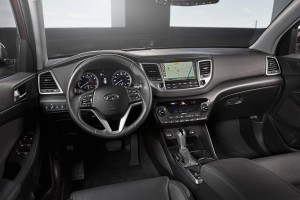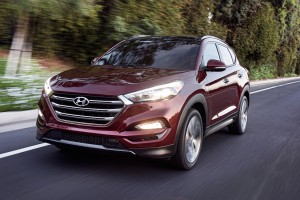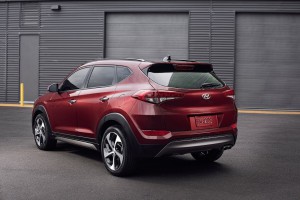Hyundai, the South Korean automaker, has become a force on the global stage by building a series of clever and well-built equipped vehicles with up-to-date technology at eminently affordable prices.
The 2016 Hyundai Tucson, a smart and capable compact utility vehicle aimed at the heart of a fast growing segment of the market, remains true to the company’s basic philosophy, while improving on a vehicle that is vital to its portfolio.
The new Tucson is roomy and comfortable, looks smart sitting at the curb, nicely furnished on the inside and delivers ample, but not overwhelming power. Moreover, the ride and handling have been measurably improved by a revamped suspension layout and lighter chassis, while the brakes deliver plenty of stopping power.
In recent years, Hyundai has been quite adept at making the interiors of vehicles look plush and expensive and the designers and engineers that prepared the 2016 Tucson for market certainly followed the company script on that front. The architecture of the interior is clean and uncluttered, but the controls are within easy reach. Soft-touch material and varied textures have been used to help elevate the appearance of the cabin.
Hyundai’s designers also have innovated. For example, a soft-touch pad is located near the driver’s right knee, for better extra comfort on long drivers and upgraded controls add refinement to the interior. The Tucson I drove was equipped with the optional full-length panoramic sunroof, adding to the cabin’s ambience.
The cabin, while quiet, isn’t exactly spacious. But the seating positions offer good visibility from both the driver and passenger seats. Hyundai has widened the track of the third-generation Tucson by 1.1 inches and lengthened the wheelbase by 1.2 inches, but it is still relatively narrow and short, which does limit the space inside the vehicle.
(Hyundai offering do-it-yourself updates for Android Auto. For more, Click Here.)
But the rear seats will hold a couple of adults and fold down for bulkier cargo when necessary, making the vehicle more versatile than a typical small sedan, and Hyundai has managed to increase the cargo space by 5 cubic feet by adding 3 inches to the length of the Tucson.
The rear seats also recline by 37 degrees making it easier for passengers to catch a nap on a long drive.
The Tucson also has a fresh exterior appearance with a strong silhouette that is emphasized by swept-back roofline and parallel character lines that run down the side of the vehicle. The front of the Tucson has also been reshaped to give it a bold and tailored look. Hyundai also made liberal use of LEDs in both the front and rear of the Tucson.
Hyundai also has become adept at turning out small displacement engines that pack punch. The base engine is a 2.0-liter, direct-injected four-cylinder with 164 horsepower and 151 lb.-ft. of torque, coupled with a six-speed automatic transmission, which is rated at 23 miles per gallon in the city, 31 mpg on the highway and 26 combined.

Hyundai continues to make efforts to better the interiors of its vehicles and the Tucson is no exception.
(Click Here for details about American’s concerns about vehicle hacking.)
But the Eco, Sport and Limited models of the Tucson come offering the new 1.6-liter turbocharged, direct-injected four-cylinder with 175 horsepower and 195 lb.-ft. of torque. The 1.6-liter engine is matched to a new seven-speed dual-clutch transmission and in the Eco front-wheel-drive models gets 26 in the city, 33 on the highway and 29 mpg overall. The 1.6-liter turbo engines in the Sport and Limited models are calibrated differently and rated at 25 mph in the city, 30 on the highway and 27 overall.
All-wheel-drive is available with both powertrains and both acquitted themselves well during the test runs. The shifts on the seven-speed were smooth and well timed, kept pace with the changes in the terrain and delivered the required power when necessary. The 2016 Tucson also performed well on the highway portion of the drive route.
The quiet cabin, sophisticated powertrain and improvements in ride and handling make the vehicle easy to drive and a very tough competitor for the Ford Escape, Honda CR-V and Toyota RAV4.
Hyundai also has also made a substantial amount of sophisticated technology available on the Tucson, including a driver assistance package with Lane Departure Warning system, Blind Spot Detection, Rear Cross-traffic Alert, Lane Change Assist, Backup Warning Sensors and Automatic Emergency Braking or AEB as it’s now being called.
A 5-inch color LCD display with rearview camera and touchscreen function is standard on Tucson. Apple Siri “Eyes Free” integration also is now available on the navigation-equipped Tucson as well as the updated version of Hyundai’s BlueLink connectivity system.
(To see more about the improvements made by Korean automakers, Click Here.)
Overall, the Tucson comes across as a good value and a good choice for buyers nervous about making a bad decision about their new vehicle. It’s also priced aggressively. Prices for the base made start at $22,700 before the addition of $895 in freight charges and the top of the line Limited model with advanced technology and premium features costs $31,300 plus freight.



The main selling point for these vehicles is the sticker price. A level playing field would require all auto makers to produce cars in the major markets/countries that they sell in with at least 75% domestic content.
Looks like a Lexus Cheroscape
The main selling points for these vehicles is their Quality and Manufacturers Warranty – which is backed up by their Dealer Network. Several models of Hyundai/Kia are manufactured here in the USA {Alabama/Georgia}. Sticker Price only becomes a factor if the Consumer can find two or more vehicles that they place equal value on. “Price” is one thing, but it is the “Value” that Customers get for their money that determines the sale.